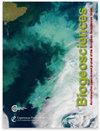利用模型数据融合估算破碎、混合用途景观碳动态的尺度差异
IF 3.9
2区 地球科学
Q1 ECOLOGY
引用次数: 0
摘要
摘要许多陆地景观是异质的。混合的土地覆盖和土地利用在精细的空间分辨率下产生了一个复杂的碎片生态系统马赛克,具有对比鲜明的生态系统种群、特征和过程,每种生态系统对环境和人类因素的敏感性都不同。在陆地生态系统模型中表现空间复杂性是理解区域碳动力学、其对环境梯度的敏感性以及其在气候变化面前的复原力的一个关键挑战。由于建模框架内生态系统表示的保真度与精细尺度模型校准和模拟所需的计算能力之间的权衡,异质性支撑了这一挑战。我们通过量化英国混合用途景观中模拟碳通量对模型分析空间分辨率的敏感性,直接解决了这一挑战。我们测试了两种不同的方法,将地球观测(EO)数据结合到CARDAOM模型-数据融合(MDF)框架中,同化基于EO的生态系统叶面积和生物量存量估计的卫星时间序列,以约束陆地C循环中等复杂度模型的模型参数估计及其不确定性。在第一种方法中,生态系统在像素级进行校准和模拟,代表所涵盖的土地覆盖和管理的“社区平均值”。这代表了我们的基线方法。在第二种方法中,我们根据土地覆盖(如针叶林、耕地/牧场)对每个像素进行分层,并使用每个地层特有的EO数据独立校准模型。我们在英国的一个混合土地利用地区测试了这些方法的尺度依赖性,网格分辨率从1到0.05∘。我们的分析表明,空间分辨率对MDF很重要。在社区平均基线方法下,CARDAOM模拟的生物碳通量(总初级生产力,Reco)对分辨率相对不敏感。然而,扰动通量表现出尺度方差,随着景观碎片化程度的增加和模型域的粗糙度的增加而增加。相反,基于精细分辨率土地利用分布的同化数据分层解决了分辨率相关性,导致扰动通量为40 %–100 % 高于基线实验。模拟干扰通量的差异导致了分层实验中陆地碳平衡的估计,这表明与基线实验相比,碳汇较弱。我们还发现,基于土地利用对模型域进行分层会导致检索到的参数存在差异,这些参数反映了对比土地利用的相邻区域之间生态系统功能的变化。土地利用层之间模型参数的突然差异导致了对未来气候变化的不同反应。因此,考虑异质景观中的精细尺度结构(如分层)对于确保大型MDF框架的生态保真度至关重要。之所以需要分层,是因为土地利用对碳储量和植物功能特征的空间分布以及控制碳在景观中流动的生态过程进行了强有力的控制,特别是与管理和干扰有关的生态过程。鉴于扰动对全球陆地碳通量的重要性,以及森林景观破碎化的普遍增加,这些结果对应用MDF框架在区域和国家尺度上限制陆地碳平衡具有更广泛的意义。本文章由计算机程序翻译,如有差异,请以英文原文为准。
Scale variance in the carbon dynamics of fragmented, mixed-use landscapes estimated using model–data fusion
Abstract. Many terrestrial landscapes are heterogeneous. Mixed land cover and land use generate a complex mosaic of fragmented ecosystems at fine spatial resolutions with contrasting ecosystem stocks, traits, and processes, each differently sensitive to environmental and human factors. Representing spatial complexity within terrestrial ecosystem models is a key challenge for understanding regional carbon dynamics, their sensitivity to environmental gradients, and their resilience in the face of climate change. Heterogeneity underpins this challenge due to the trade-off between the fidelity of ecosystem representation within modelling frameworks and the computational capacity required for fine-scale model calibration and simulation. We directly address this challenge by quantifying the sensitivity of simulated carbon fluxes in a mixed-use landscape in the UK to the spatial resolution of the model analysis. We test two different approaches for combining Earth observation (EO) data into the CARDAMOM model–data fusion (MDF) framework, assimilating time series of satellite-based EO-derived estimates of ecosystem leaf area and biomass stocks to constrain estimates of model parameters and their uncertainty for an intermediate complexity model of the terrestrial C cycle. In the first approach, ecosystems are calibrated and simulated at pixel level, representing a “community average” of the encompassed land cover and management. This represents our baseline approach. In the second, we stratify each pixel based on land cover (e.g. coniferous forest, arable/pasture) and calibrate the model independently using EO data specific to each stratum. We test the scale dependence of these approaches for grid resolutions spanning 1 to 0.05∘ over a mixed-land-use region of the UK. Our analyses indicate that spatial resolution matters for MDF. Under the community average baseline approach biological C fluxes (gross primary productivity, Reco) simulated by CARDAMOM are relatively insensitive to resolution. However, disturbance fluxes exhibit scale variance that increases with greater landscape fragmentation and for coarser model domains. In contrast, stratification of assimilated data based on fine-resolution land use distributions resolved the resolution dependence, leading to disturbance fluxes that were 40 %–100 % higher than the baseline experiments. The differences in the simulated disturbance fluxes result in estimates of the terrestrial carbon balance in the stratified experiment that suggest a weaker C sink compared to the baseline experiment. We also find that stratifying the model domain based on land use leads to differences in the retrieved parameters that reflect variations in ecosystem function between neighbouring areas of contrasting land use. The emergent differences in model parameters between land use strata give rise to divergent responses to future climate change. Accounting for fine-scale structure in heterogeneous landscapes (e.g. stratification) is therefore vital for ensuring the ecological fidelity of large-scale MDF frameworks. The need for stratification arises because land use places strong controls on the spatial distribution of carbon stocks and plant functional traits and on the ecological processes controlling the fluxes of C through landscapes, particularly those related to management and disturbance. Given the importance of disturbance to global terrestrial C fluxes, together with the widespread increase in fragmentation of forest landscapes, these results carry broader significance for the application of MDF frameworks to constrain the terrestrial C balance at regional and national scales.
求助全文
通过发布文献求助,成功后即可免费获取论文全文。
去求助
来源期刊

Biogeosciences
环境科学-地球科学综合
CiteScore
8.60
自引率
8.20%
发文量
258
审稿时长
4.2 months
期刊介绍:
Biogeosciences (BG) is an international scientific journal dedicated to the publication and discussion of research articles, short communications and review papers on all aspects of the interactions between the biological, chemical and physical processes in terrestrial or extraterrestrial life with the geosphere, hydrosphere and atmosphere. The objective of the journal is to cut across the boundaries of established sciences and achieve an interdisciplinary view of these interactions. Experimental, conceptual and modelling approaches are welcome.
 求助内容:
求助内容: 应助结果提醒方式:
应助结果提醒方式:


